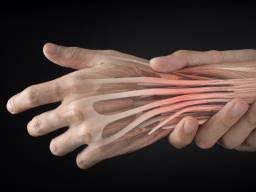By: Dr. Alyssa Musgrove
When you feel a new, painful twinge in your body, it is common to wonder if it might be your arthritis spreading. However, not all pain is arthritis related. It is possible the new, painful area is caused by a condition commonly known as tendonitis.
Tendons are thick, fibrous cords that connect muscles to bone. When a muscle contracts to move a bone, the tendon supports that action. Tendonitis is inflammation or irritation of a tendon and usually occurs near a joint, which is why it is often mistaken for arthritis. It can affect people of all ages, sizes and levels of physical activity, however it is most common in adults over the age of 40. 
Tendonitis is most commonly caused by overuse or repetitive movement patterns. Some forms of tendonitis are named after the sports in which they commonly occur, such as tennis elbow, jumper’s knee, pitcher’s shoulder and golfer’s elbow. Tendonitis can also be caused by physical activities of a longer duration that are outside of your normal routine. For example, power washing the pollen away, spreading pine straw or cleaning the boat. Similarly, a longer walk than usual, or a walk on a terrain that is not routine exercise for you, can also cause sudden tendon irritation. Other common activities that can trigger tendonitis include dancing, gardening, cleaning or skiing without proper warm up or stretching afterward.
Tendonitis typically involves pain that worsens with motion, and improves with rest and appropriate treatment. Symptoms can reoccur in the same area of the body and include redness, swelling, and warmth at the site. Some types of tendonitis can occur suddenly and last for a few days, while other types accumulate over time and last for weeks to months.
If the cause of your tendonitis is over-use, you may be told to rest the area and reduce (or avoid) the particular activity. Cold therapy is a great first line of defense to help reduce pain and swelling. A general rule of thumb is to apply ice to the area for 15-20 minutes, followed by at least 20 minutes off. This cycle can be repeated every 2 to 3 hours for the first 24 to 48 hours after your injury. (Never place ice directly on the skin. Always cover the skin with a light absorbent towel, piece of clothing, paper towel or dish towel to prevent frostbite. If you don’t have an ice pack, a bag of frozen peas or corn will work just fine.)
Certain supplements can also be helpful in lowering inflammation and nourishing damaged tissues. Omega-3 oil is an anti-inflammatory fat needed to control swelling. It is most commonly found in wild-caught fish but can be supplemented in higher doses as a pill or liquid. Turmeric can be used in cooking or also taken in capsule form, tea or essential oil. Bromelain is an enzyme in pineapple that has anti-inflammatory effects and aids in tissue repair. Collagen makes up ligament and tendon tissue. It can be taken in powder form, or consumed as bone broth, to restore your supply and strengthen weakened areas. MSM is a source of sulfur that is necessary for proper tendon function.
Ensuring the correct body position and correct posture during the problematic activity is important when trying to prevent the injury from recurring. Warming up the tissues and area before, during and after the activity is also useful. Start new exercises slowly. Pace yourself when undertaking abrupt, abnormal chores. Take enough rest days between workouts if you are starting a new routine as your tendons need time to catch up with any new form of movement.
Sometimes supporting the area with a splint, wrap bandage, compression sleeve or kinesiology tape can help take pressure off the tissues and allow them to heal. Kinesiology tape is a therapeutic tape applied strategically to the body to support tissue, decrease pain and swelling, and improve performance. It is best to consult with a medical provider or physical therapist who is trained in the proper application before you try to apply it yourself. Corticosteroid injections are a more invasive option that can provide short-term pain relief for tendonitis. These powerful anti-inflammatory drugs are injected directly into a joint or tendon at a doctor’s office.
If tendonitis continues, or you ignore symptoms and overuse an unhealed injury, there is a possibility of the tendon rupturing or developing lesions on the tendon that may require surgery. The best treatment for tendonitis depends on case history and a physical exam to rule out any other conditions or problems. A chiropractor can assess your posture, give you tips for performing certain activities in a safer way, increase flexibility by making sure the nervous system is working properly and increase joint mobility.
Pathways to Healing specializes in holistic chiropractic care. Dr. Alyssa Musgrove draws on a variety of techniques, including chiropractic, kinesiology, nutrition, food allergy testing and lifestyle counseling to assist clients in achieving optimal health and wellness in one setting. Pathways to Healing is located at 1022 Founders Row, Lake Oconee Village, Greensboro. The office can be reached at 706-454-2040.